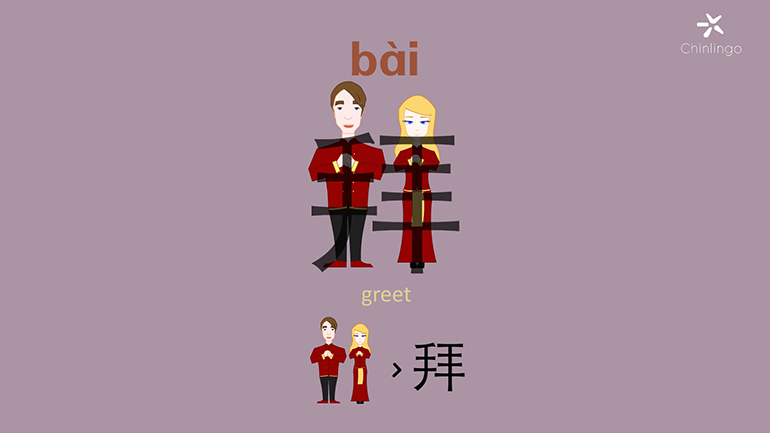
China has been known as a nation of courtesy and propriety. It attaches much importance to ceremony at every festival.
中国自古就是礼仪之邦,逢年过节,纪念庆典中的礼仪十分讲究。
The character "拜" (bài) consists of the ideographic radical "手", which indicates the origin. "拜", meaning "worship", refers to a salute to show greeting and respect by raising one's both hands over head when he or she meets someone. The salute given at an ordinary meeting is called "拜见" (bài jiàn), which is often used when a young man visits an elder or a junior visits a superior. If this salute is given in the Spring Festival holiday, it's called "拜年" (bài nián), which means "pay a visit to relatives or friends and wish them a happy new year".
汉字"拜"(bài)以"手"为部首表义,道出了它的由来。"拜"(bài)即是指会面时,双手举过头顶,以示问候、表示尊敬的一种礼节。如果在平时见面时行这个礼,就是"拜见(bài jiàn)",这个词语常用于晚辈对长辈,下级对上级的拜访。如果在过年时行此礼,就是 "拜年(bài nián)",这个词语指的是过年时到访亲戚朋友的家,祝贺他们新年快乐。
Of course, besides a salute, gifts are necessary for "拜见" or "拜年" to further show your regards. Thus, the right part of "拜" consists of four horizontal strokes and one vertical stroke crossing the four horizontal ones, as if four gifts are bundled by a string.
当然,会面、拜年时除了行礼之外,也免不了提点礼物,进一步表明心意。因此,"拜"的右边四个横线就如四份礼盒,一个竖线交叉其中,就如礼带将礼物都串绑了起来。
The structure of "拜" is clear: the ideographic radical "手" on the left indicates its original meaning "make obeisance", while the four horizontal strokes and the vertical stroke on the right can be imagined as a bundle of gifts. Remember that you should pay attention to writing its left part "手", which should be "丿" instead of "亅".
由此,汉字"拜"的结构清晰可见:左右结构,以"手"为部,部首在左(书写时贴别注意,需要将笔画竖钩变体为"丿"),表明其原始含义——用手行礼。右边的四横一竖可视作加强部分。想象为四份厚礼相连,加强礼仪的强度。
Please visit Chinlingo for Chinese learning.



 闽公网安备 35020302035673号
闽公网安备 35020302035673号
0 responses on "Chinlingo Chinese character: 拜"